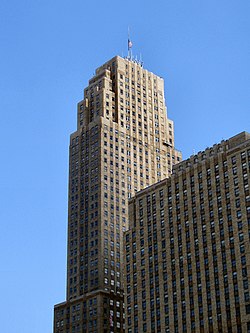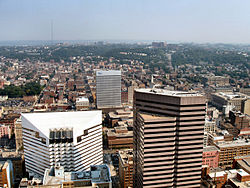Carew Tower
Carew Tower-Netherland Plaza Hotel | |
 View from the base | |
| Location | W. 5th St. and Fountain Sq., Cincinnati, Ohio |
|---|---|
| Area | 10 acres (4.0 ha) |
| Built | 1930 |
| Architect | W.W. Ahlschlager & Associates with Delano & Aldrich |
| Architectural style | Art Deco |
| NRHP reference No. | 82003578[1] |
| Added to NRHP | August 5, 1982 |

Carew Tower is the second tallest building in Cincinnati, Ohio, United States. Completed in 1930, it stands 49 stories tall in the heart of downtown, overlooking the Ohio River waterfront, and is a National Historic Landmark. It contains the Hilton Cincinnati Netherland Plaza (formerly the Omni Netherland Plaza). The hotel is described as "one of the world's finest examples of French Art Deco architecture." The building was eclipsed by the Great American Insurance Building at Queen City Square on July 13, 2010 rising 86 feet (26 m) higher than the Carew Tower. It is named for Joseph T. Carew, proprietor of the Mabley & Carew department store chain, which had previously operated on the site since 1877.
History
The building was designed by the architectural firm W.W. Ahlschlager & Associates with Delano & Aldrich and developed by John J. Emery. The original concept was a development that would include a department store, a theater, office accommodation and a hotel to rival the Waldorf-Astoria. Emery took on as partner Col. William A. Starrett (Starrett Investment Corp.) and Starrett Brothers, Inc. as general contractors. [2] [3]The building is widely considered to be an early prototype of an urban mixed-use development, a "city within a city". New York City's Rockefeller Center, built around the same time, is a more famous example of this concept. To make the site available the Carew Building, an office block belonging to Mabley & Carew, and the Hotel Emery were demolished. [4]
Construction began in September 1929, just one month before the stock market crash on October 24 that triggered the Great Depression. Because of this, construction was continued on a modified plan. The grand details (architectural motifs, friezes, and decorative metal) that are common on art deco buildings were stopped at the third floor and plain bricks were used on the floors above. Art deco themes can be found throughout the building, particularly in the metalwork and grillwork of the elevators and lights. Rookwood Pottery floral tiles add the "Cincy" touch to the building. Sculpture on the exterior and interior of the building were executed by New York architectural sculptor Rene Paul Chambellan.

The total cost of the building was US$33 million, which at that time was an enormous amount of money. It took crews only 13 months to complete the construction, working 24 hours a day and 7 days a week.
From 1930 until 1960, the Carew Tower was the home of the Mabley & Carew department store.
From 1967 to 1980, the Carew Tower and the neighboring PNC Tower, then called the Central Trust Bank tower, were featured in the opening and closing credits of the long-running daytime soap opera The Edge of Night, since Cincinnati was the stand-in for the show's fictional locale of Monticello. Coincidentally (or not), Procter & Gamble the show's producers, are based in Cincinnati.
Today the building is home to a mixed crowd of tenants, including a shopping mall, the Hilton Cincinnati Netherland Plaza, and offices. Visitors can pay $2 each to access the observation deck, which is located on the 49th floor. On a clear day, visitors can see for miles in all directions, and three states (Kentucky, Indiana, Ohio). Because of its architectural standards, as well as its identity with the city's heritage, Carew Tower was designated a National Historic Landmark in 1994.
The building originally had three towers, the tallest housing offices, the second the hotel, and the third serving as a parking garage which had an elevator rather than traditional ramps for access. There was also a turntable for vehicles to assist in pointing delivery trucks in the right direction. The system has since been dismantled. During the mid- to late-1980s a giant inflatable gorilla was attached to the upper floors.
Statistics


Name & location
| Official Name: | Carew Tower |
| Namesake: | Joseph T. Carew |
| Address: | 441 Vine Street Cincinnati, Ohio 45202 |
| Cross streets: | Vine Street West 5th Street |
| Zone: | Fountain Square |
| Neighborhood: | Central Business District / Riverfront |
| District: | District 1 (center) |
| Current status: | In use (designated National Historic Landmark in 1994) |
Technical data
| Height (structure): | 574 ft (175 m) |
| Floors: | 49 |
| Construction begin: | September, 1929 |
| Construction end: | January, 1931 |
| Elevators: | 41 |
Construction
| Type: | High-rise building |
| Structural materials: | Steel |
| Facade materials: | Brick |
| Architectural style: | Art deco |
| Original cost (1929): | $33,000,000 |
Statistics
- 1.383 million square feet (128,000 m²) of total floor area
- 9 miles of brass piping
- 15 railroad cars full of glass
- 37 miles of steel piping
- 40 railroad cars full of stone
- 60 miles of floor and window molding
- 60 railroad cars full of lumber
- 4500 plumbing fixtures
- 5000 doors
- 8000 windows (upon its completion in 1931)
- 15000 tons of structural steel
- 4 million bricks in the outer structure
See also
References
- ^ "National Register Information System". National Register of Historic Places. National Park Service. 2009-03-13.
- ^ Painter, Sue Ann. Architecture in Cincinnati: An Illustrated History of Designing and Building an American City, Athens, Ohio: Ohio University Press, 2006.
- ^ National Historic Landmark Nomination.
- ^ http://www.emporis.com/application/?nav=building&id=122028&lng=3

